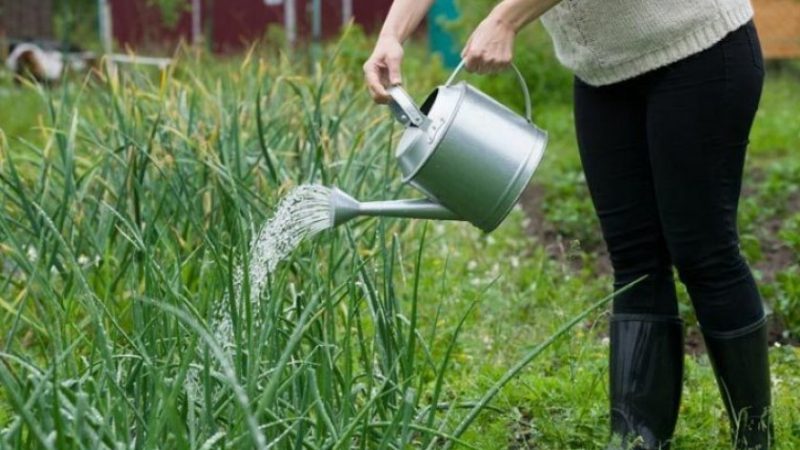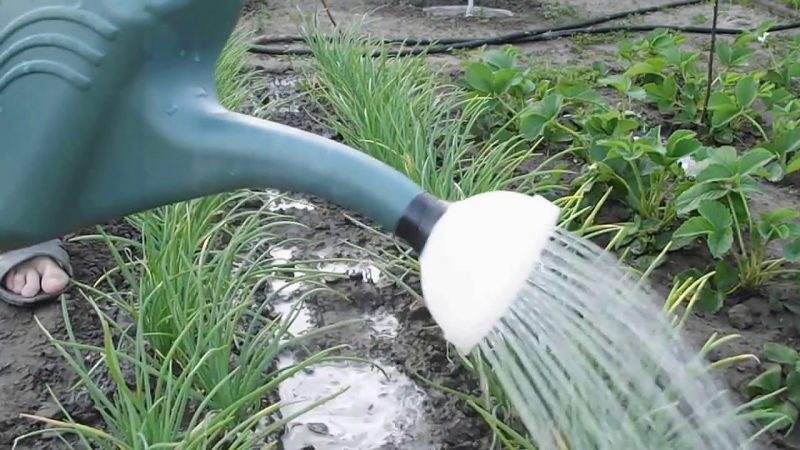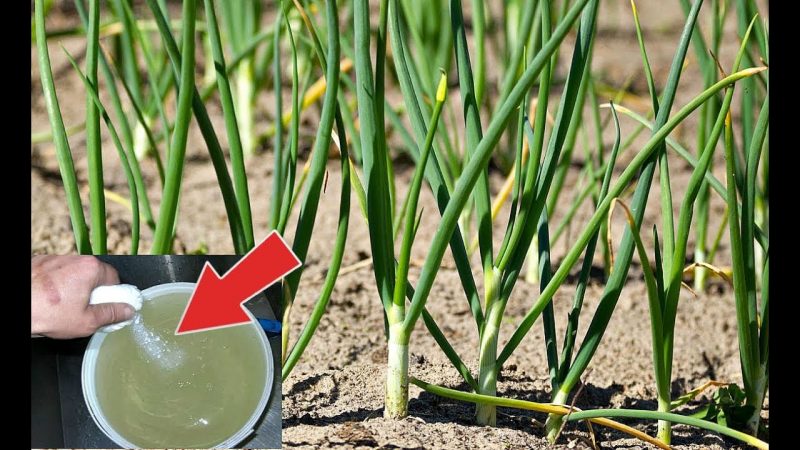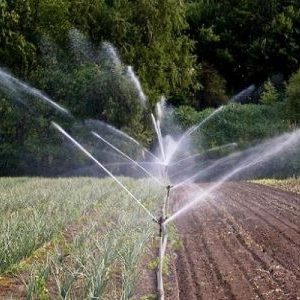How to properly water onions in the open field and in the greenhouse
Onions are a very ancient culture, known for over 5 thousand years. The rules for its breeding have already been thoroughly studied, but still summer residents do not always get good harvests. The requirements for the conditions of watering and nutrition of this crop differ at different stages of growth, depending on the purpose of cultivation: for a turnip, for forcing greens, for getting seedlings. Let's analyze these nuances in our today's article.
The content of the article
- General rules and norms for watering onions
- How to water properly
- How to water at different stages of the growing season
- Overflow hazard
- How and why to water onions with nutrient mixture
- Watering green onions in the greenhouse and open field
- How to water seed onions
- Features of sprinkler irrigation systems
- Tips & Tricks
- Conclusion
General rules and norms for watering onions
Onions are a stable and non-capricious crop, but for normal growth they need a suitable planting site and an optimal irrigation regime.
Why water onions
The vegetative parts of the plant are, on average, 90% water. The size of the bulbs directly depends on the timeliness and amount of watering. To increase the organic matter (both turnip and greens), onions require a lot of nutrition. Water provides plants with access to nutrients that need to arrive regularly and evenly.
The lack of moisture serves as a signal to stop the vegetative process and start ripening of the bulbs.

When and how often
Especially important is the moisture schedule at the stages of root formation, foliar growth and the bulb itself.
After planting, the plant is actively watered. During this period, the soil moisture indicator is maintained within 70%. Once the bulbs have reached optimum varietal size, watering is reduced, and at the stage of maturation, they stop altogether.
Important! They take warm water for irrigation. Fresh well or tap water is not used without preliminary infusion. The approximate norm is a bucket of liquid per 1 m2 of plantings. This volume is adjusted for rainfall and soil conditions.
When forcing on a feather, the onion is moistened throughout the growing season.
How to water properly
Correct watering ensures constant uniform soil moisture to the depth of the root system spread without the formation of a soil crust and moisture stagnation. Onion irrigation methods are sparing: sprinkling (for greenery), between rows (for turnip), drip method.
In the open field
Atmospheric and soil processes significantly affect the moisture schedule of vegetable beds. The need for the next watering is determined by checking the condition of the soil at a depth of several centimeters.
Attention! It is important to avoid getting liquid on the bulbs to prevent them from starting to rot. Regulation of water pressure will not allow soil erosion.
Vegetables are irrigated in the morning or evening, not in hot weather. This will prevent leaf burns and the soil from drying out quickly. The water is used warm (+ 17 ... + 18 ° C).
In the greenhouse
Onion cultivation in greenhouses is practiced year-round, mainly for forcing high-quality abundant greens (per feather)... In addition to the usual onion, perennial varieties are used: leeks, batun, shallots and others.
Onions are planted on a feather more densely than on a turnip. Water the culture from a watering can (sprinkling) with warm water as the soil dries up.Usually humidified less frequently than outdoors (in dry weather), since there is less ventilation in greenhouses and constant air humidity is maintained. In some greenhouses, onions are grown hydroponically.
Drip irrigation
Drip irrigation is the most effective method because:
- prevents the risks of waterlogging and soil erosion;
- significantly saves water resources, including reducing waste water losses;
- allows you to dosed fertilization;
- protects bulbs and feathers from burns and soaking;
- maintains good soil characteristics: mineral composition, looseness, etc.
Simultaneously with drip irrigation, fertigation is carried out (the culture is fed with liquid fertilizers).
How to water at different stages of the growing season
The main secrets are varying the watering rates at different stages of growth.

Before boarding
Before planting onions, the soil is spilled to a great depth with a double dose of liquid. It is advisable to use not just water, but a weak solution of potassium permanganate for disinfection.
With such abundant watering, the seedlings are planted the next day, when the soil reaches optimum moisture.
With early spring planting, when there is still a lot of natural moisture in the ground, pre-planting irrigation of the beds is not necessary.
Immediately after landing
After planting the seed, the soil is moistened to start the growing processes. Even with an autumn planting before winter, the set must take root before leaving "to rest" until spring.
When seedlings appear and during a period of active growth
It is important for onions that the soil layer at a depth of 10 cm remains evenly moist.
Attention! The main thing in determining the need for watering is the dryness of the soil in the root layer. It is unacceptable to bring to the appearance of cracks on the surface of the earth.
In the open air, the frequency of irrigation is determined depending on weather conditions (in the absence of rain - 1-2 times a week). In the greenhouse, watered every 10 days.
Bow on feather
Feathers form succulent if there is enough nutrients in the bulb. Water the culture abundantly throughout the entire period of greenery growth (taking into account the temperature conditions in the greenhouse). At rates of about + 15 ... + 20 ° C, water is moderately, once a week, on average, 3 liters per 1 m2. With a significant increase in air temperature (more than + 25 ° C), both the frequency of humidification (once every 4-5 days) and the volume of liquid (3-4 liters per 1 m2) are increased.
Before harvest
The intensity of watering is reduced when the peak of growth processes passes. Lodging of tops in 30–40% of plants serves as a signal for a decrease in moisture. There is no need to stimulate the growth of new leaves. During this period, nutrients move from the green mass and are concentrated in the bulb. When the feathers begin to actively turn yellow and dry out, watering is stopped altogether.
How to water a large onion
The peculiarity of irrigation of grown onions is associated with the need to protect the already formed heads from getting wet. Rain and root methods of planting moistening are replaced with irrigation technique between rows.
The soil in the onion plantings is loosened superficially so as not to damage the roots lying in the upper layer.
Overflow hazard
Despite the increased need for water onion, at certain stages of growth it is important not to overdo it with moisture.
Attention! Excessive watering, especially on heavy soils, promotes the development of rot in plants.
With an excess of moisture, the bushes are affected by powdery mildew, the bulbs crack, and weeping areas appear on them. When the first signs of damage appear, irrigation is stopped.
When to stop watering
For full ripening of the bulbs 1-2 weeks before harvesting watering is stopped (approximately from late July - early August).
The time for collecting green feathers comes when they reach the required length. In this case, they stop moistening the culture 2-3 days before the planned cut so that the feathers do not deteriorate from the liquid.
How and why to water onions with nutrient mixture
The onion selects a large supply of nutrients from the soil, therefore, fertilizing irrigation has a beneficial effect on it.
Salty water
Often, gardeners fertilize onion plantings with salt water. It is affordable and economical, and salt not only contains elements beneficial to the culture, but also repels harmful insects (for example, onion flies).
For protection and feeding, plants are watered with salt water no more than 3 times per season with an interval of 2-3 weeks. For the solution, take 200-300 g of salt in a bucket of water. Pour at the root.
Important! Frequent watering with salt water degrades the quality of the soil, salting it. To neutralize this negative effect, at the end of the season, a double portion of organic fertilizers is applied to the beds.
A few hours after this treatment, the bed is irrigated with ordinary heated water.
Water with dressing

With good pre-planting fertilization of the beds, the first root dressing is applied after 2-3 weeks. It is better to use organic fertilizer, since at first onions need nitrogen.
Until the end of July, under normal planting conditions, complex fertilizers are added with the same frequency. If signs of starvation appear (pallor of feathers, slow development of bulbs), the composition and sequence of dressings are adjusted.
Watering green onions in the greenhouse and open field
Precipitation does not enter the greenhouse, so the humidification schedule here differs from that used outdoors.
In the open field, the culture is watered 1-2 times a week (depending on the weather). The soil is soaked to a depth of 10 cm, then the soil is carefully loosened between the rows, which ensures uniform soil moisture and prevents crust formation.
In the greenhouse, the watering schedule is clear, usually every 10 days. Loosening of the soil is replaced by mulching, since the onion planting is more dense under such conditions.
How to water seed onions
There are three methods of growing onions from seeds:
- a two-year cycle in which sets are obtained in the first year;
- growing bulbs from seeds in one year;
- seedling method.
To obtain healthy seedlings, the culture is irrigated 1-2 times a week as it grows. Watering is stopped at the stage of ripening of seed bulbs.
Before sowing in early spring, the bed is disinfected with hot water, the seeds are laid out in grooves, sprinkled with humus and covered with a film to preserve moisture. The film is removed only after the emergence of shoots. In the future, standard irrigation and feeding are carried out, as mentioned earlier.
In the third method, seedlings are first grown from seeds at home. The crops are sprayed so as not to damage the delicate shoots. After diving into the open ground for the first week, the seedlings are moistened daily for successful rooting. Follow-up care for onions is standard.
Features of sprinkler irrigation systems
Sprinkler irrigation is effective for lawn maintenance, greenhouses and large areas of crops.
The installation itself is a system of pipes with water spraying nozzles - sprinklers. The sprinkling effect is created by means of diffusers in the nozzles. Such a device has a more favorable effect on plants, even compared to drip irrigation.
Features of sprinkler humidification:
- optimal frequency and rate of watering in any weather;
- there is no risk of soil erosion or soil crust formation;
- not only the root system is moistened, but also the surface layer of air;
- moisture and feeding mixtures are distributed evenly;
- the temperature of the soil decreases, which prevents it from drying out.
The cost of sprinkler irrigation is high, but in the southern regions of our country, its use is economically profitable.
Tips & Tricks
To obtain a high-quality harvest, vegetable growers observe some of the subtleties of growing onions:
- To accelerate ripening in the second half of the growing season, the bulbs are undone or pulled up with partial breakage of the roots.
- In prolonged rainy weather, film canopies are arranged over the onion beds, protecting the culture from getting wet. This is especially true in August.
- Water the vegetable evenly, otherwise low-quality bulbs will form with alternating juicy and dry scales, which will adversely affect the shelf life of the crop.
Read also:
How to eat onions for weight loss: recipes for dietary meals.
Stop crying in the kitchen: learn to cut onions without tears.
How to water cucumbers in a polycarbonate greenhouse: instructions and basic rules.
Conclusion
A balanced irrigation regime is the main condition for obtaining a rich and high-quality harvest of green or onions. The correct organization of irrigation provides not only the observance of quantitative norms, but also the optimal frequency of moisture at different stages of the growing season.